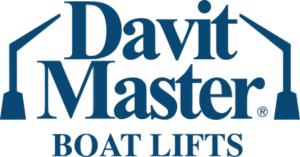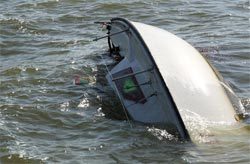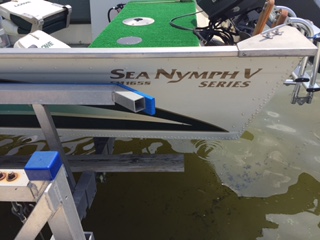Jan 26, 2024
A Guide to Capacity and Travel
You worked hard to buy the boat of your dreams. When you finally get the time to enjoy it, you don’t want to waste time getting it into the water. That is why so many waterfront owners choose to purchase boat lifts to store their vessel on site. Image the convenience of being in the water in minutes, while also keeping your boat safe and clean.
In order to achieve this, it’s important you choose the right boat lift to ensure the safety and longevity of your vessel. This guide will explore the key factors to consider when selecting a boat lift.
Understanding Capacity
Dry Weight vs. Operating Weight:
The first question you’ll need to answer when looking for a boat lift is, “What is the weight of your boat?” Your first thought will be to check your boats specifications, but there are many factors that contribute to your boats actual weight that are not listed in your boats specifications. The dry weight listed for boats often excludes outboard motors, fuel, fluids, gear, and accessories. You will need to consider the combined weight of these additional items when choosing lift capacity.
- Adding a 20% buffer to the total weight provides a safe margin for unforeseen variations.
- Overestimating capacity is wise if you plan to upgrade to a heavier boat in the future.
People and Cargo:
We know your time is limited and you want to spend as little time getting onto the water as possible. Storing your gear right on the boat is one of the biggest advantages of having your boat stored on site. You may not realize how much additional weight even the most typical items can add to your vessel. Now add a passenger or two. As you board your boat, you want to ensure easy access, especially for those who might not get around as easily anymore. To safely do this, you want to make sure you have taken these extra pounds into account.
- As per manufactures, boat lifts are not meant to carry people while in operation. Be sure to load and unload passengers with minimal time spent on the lift.
- As per manufactures, pontoon boats are not suitable as recreational decks while on the lift. With the proper increase in capacity, you could feel safer enjoying your boat even when it’s docked.
- Overloading the lift can cause serious injuries, and damage to both the boat and the lift itself.
Understanding Travel
The travel of a boat lift refers to the distance from its lowest position to its highest position. When the lift is in its highest position, you want to make sure the keel of your boat is high enough out of the water to avoid wave action. At its lowest position, you want to make sure you have enough water depth to freely float your boat off the lift.
Wave Action:
- Areas with strong waves necessitate a lift that elevates your boat sufficiently.
- Some lifts offer extended lifting ranges for optimal clearance in challenging conditions.
- Specific brands allow you to move small watercrafts away from the water entirely.
Water Depth:
- Knowing your water depth is crucial for selecting the appropriate lift type.
- Every body of water has daily and seasonal fluctuations, make sure you know the highs and the lows of your particular body of water.
- Shallow water may require a lift specifically designed for low water conditions.
- The lift’s minimum depth requirement needs to accommodate the draft of your boat.
Popular Boat Lift Options
Everyone’s needs are unique to their slice of paradise and the equipment they use. That’s why we have partnered with the industries top boat lift manufactures, so that we can provide a boat lift solution that fits your needs.

Offers cable and hydraulic lifts with capacities ranging from 1,200 lb to 12,500 lb.
Cable lifts have a 5’6” lifting range and require 12″ of water depth plus the boat’s draft.
Hydraulic lifts offer up to 5’ of lifting range and require 18″ of water depth plus the boat’s draft.

Offers hydraulic lifts with capacities ranging from 2,000 lb to 30,000 lb.
Hydraulic lifts have a maximum 6’6” of lifting range, ideal for areas with strong waves.
Lifts can be adapted for extremely low water levels with their shallow water kit.

PWS offers Swinger lifts and Elevator lifts with capacities ranging from 1,500 lb to 16,000 lb.
Swinger lifts have a travel range of 8’6” and Elevator lifts have a customizable travel range.
Swinger lifts have the ability to rotate your craft 180° to move it away from the water completely.
Elevator lifts can operate at a 45° angle, making them ideal for overcoming obstacles.
Professional Assistance
PWS: Your Trusted Boat Lift Partner
Choosing the right boat lift can be complex, seeking professional assistance is recommended. PWS offers a comprehensive selection of ShoreMaster, SunStream and Davit Master boat lifts to meet your specific needs. Our experienced team can help you choose the right lift for your boat, water depth, and wave conditions.
Contact us today at (920) 493-4404 for a free consultation.
Additional Resources:
Jun 16, 2020
A Boat Lift Safety Lesson

My lift cable broke…and I can’t ….
Proper boat lift safety means you won’t have to learn the tough lesson pictured here. If you apply these recommendations, you can relax and enjoy your boating experience.
Failure to follow these safety suggestions may result in damage to your boat or even personal injury.
Boat Lift Safety = Never exceeding the Ratings
The rated capacity of any lift is the maximum capacity, and you should never exceed that amount.
Boat weight INCLUDES more than just the published weight of the boat. It also includes the weight of fuel, water, and equipment. After all, you will be lifting all of this when you raise your boat. It adds up very quickly!
Plus, we recommend that you allow at least a 300-500# margin of error when you calculate the boat weight. See also: Sizing a Boatlifts: How to select the correct Boat Lift.
If you ever hear a salesperson say, “You can easily go 40% or 50% over that rating without a problem”. You are at risk of being the owner of the boat above if you follow that flawed thinking.
What’s the real story?
Lift cables are rated much higher than the rating of the boat lift. As an example, (using imaginary numbers) your boat lift has a 4,000# rating, it could have cables rated for 6,000# to 8,000#.
The cable rating may be 6,000#, but ONLY if the wires are in perfect shape – meaning no burrs, kinks, frays, or rust. These defects reduce the load capacity of the cables.
The lift racks are correctly rated for the weight regardless of the cable ratings. If someone is trying to sell you a 4,000# lift and telling you that it can handle up to 4,700# – WALK AWAY!!
The load must also be “balanced” on the rack for proper boat lift safety. (More on this later)
Lift cables fail without warning
Sorry!! Cables don’t “creak” or “groan” as a warning of impending danger. The only sound you hear is a loud “snap” followed by the sound of your boat hitting the water.
In a storm, you want to get your boat as high above the water as possible. Yet, raising a boat until the lifting platform or rack hits the frame is NOT the way to do it.
Hitting the frame is an all too common occurrence. Ask yourself, if raising the boat that extra ½” is worth snapping a cable. You risk damage to your boat and lift, or worse yet, personal injury.
Operate Lift Motors properly or break a cable
Properly used, an electric lift motor is a real back saver! I wouldn’t be without one. But you need to exercise extra care when using a lift motor. Shutting off a lift motor does not mean the lifting action will stop. What if it “drifts”?
For example, one brand of lift motor “drifts” after the motor stops. The “drift” potentially causes the lift rack and frame to jam together.
Cable failure, lift or boat damage, personal injury, or worse may be the result.
When the rack hits the lift frame, something has to give. The most likely culprit will be the cables. If you combine a damaged cable with a rack hitting the frame, you have a recipe for disaster.
OK, You Jammed the Rack & Frame! – What comes next?
You were distracted, and now the rack is jammed against the frame. A jammed rack means your next step is critical.
You’re in a hurry to release the pressure, but be sure you know which way the motor will go when you flip the switch.
If the rack isn’t going “DOWN,” damage occurs almost instantly. If it is a broken cable – your boat goes down – even faster!! Starting the winch or motor in the wrong direction could mean your boat will be in the water in an instant. Did I mention it won’t be floating?
Proper Positioning of the boat is part of boat lift safety.
As if a jammed rack wasn’t enough, did you know there are right ways and wrong ways to position your boat on your lift?

Boat stern overhanging too far
All lift ratings are based on a “balanced load.” In other words, the weight of the boat must be relatively equal on each end of the rack.
When you put the majority of the weight on one end of the rack, cable breakage is more likely.
The heaviest part of any boat will be where the engine is mounted. That could be at the stern (outboards) or even near the middle of the boat (inboards).
A boat placed too far forward on the lift rack results in excessive weight on the “front” of the lift. Too far to the stern of the boat puts too much weight on the rear cables. If the cables have weakened by corrosion or fraying, you risk impending disaster.
What is the correct position for a boat on a lift?
You can determine the proper positioning of a boat by placing the stern of the boat within 12″ – 18″ of the rear lift rack. Now, raise the rack slightly out of the water.
Next, try to lift the bow end with your hands. If the boat weighs 3,500# and you can lift the front of the boat, you are either “Mr. Atlas” or the boat is positioned to the rear. If you can lift the bow at all, your boat is too far back. The weight is not evenly distributed across the four corners of the lift. Lower the boat and reposition it forward.
The boat shown here overhangs about 36″ from the rack and risking major damage. By placing the boat too far back on the rack, a majority of the weight is on the rear cables. What if those cables are weak from corrosion or fraying?
Does high water affect the positioning of a boat?
Yes, it does. In the example above, with the rear of the rack overloaded, the boat has only minimal weight on the front rack.
Your boat will float on a wave. When the bottom of the boat is “lapped” by a wave, it will try to raise the boat. With repeated lifting (or bouncing) the boat can work it’s way off the rack. It will try to go go to the rear. Eventually, the boat will literally “bounce” right off the lift.
With a balanced boat, you have a better chance of the boat staying on the rack.
Align the boat in the same position each time.
So, now you have repositioned your boat until you found a good position for a balanced load. What comes next?
It’s time to make a note of a fixed object on the boat and how it lines up with something on the lift. This is a good gauge for the next time you enter your lift. Always try to go back to this same position.
Summary
You now know the do’s and don’t of boat lift ratings and positioning for your boat. With this knowledge, you can Relax and Enjoy your boating experience.
Where is Pier & Waterfront Solutions?
Located at 7325 St. Hwy 57, it’s 3 miles south of Sturgeon Bay, and 1 mile past the intersection of Cty MM (heading north). Look on the right side, one mile north, at the next intersection (Idlewild Road and Hwy 57).
ARE WE OPEN?
During this time of uncertainty, Pier & Waterfront Solutions is staying “open.” We have implemented measures to ensure the safety of our employees and visitors. At the same time, we are working to maintain the trusted service that you have come to expect.
We are implementing these precautionary measures:
1. Conducting as much business as possible by email, text, or phone.
2. Site visits will continue but with limited in-person meetings. When in-person contacts are necessary, we will follow “social distancing” guidelines.
3. Our display yard is always open for you to examine at your leisure. All displays have a numbered, red tag on them. If you want more information or pricing, please reference that number.
That’s not all!
4. Some employees are working remotely, but they are always available by phone.
5. Any employee exhibiting symptoms or illness is sent home.
6. We provide estimates and invoices by email to make the process paperless and faster.
7. Crew starting times are being staggered to limit social interactions.
8. We keep the same crews together to limit cross interactions.
With these measures, we hope everyone will stay safe, and we will be back to normal operations soon.
What can YOU do to help us?
1. Please conduct as much business as possible via emails, messaging, and emails. This step protects everyone involved.
2. When you see our crews installing equipment, please practice “social distancing.”
So, YES – WE ARE OPEN!
Please call, message, or email us with any questions.
Thank you for allowing us to work with you.
Let’s all stay safe!
Contact:
Jerry @ (920) 493-4404 or Jerry@wisconsinpws.com – Commercial work & new/used Sales.
Dave @ (920) 905-2588 or Dave@wisconsinpws.com – Erosion control & shoreline work.
Jerry @ (920) 493-4404 or Jerry@wisconsinpws.com – Scheduling & Service work










